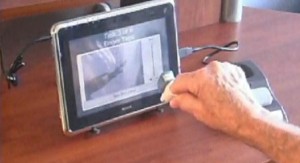 Parkinson's disease is considered a movement disorder, so it lends itself quite well to mobile technologies. At least one tablet-based device to measure Parkinsonian tremors is already on the market, while an iPhone measurement system passed muster in a clinical trial more than a year ago.
Parkinson's disease is considered a movement disorder, so it lends itself quite well to mobile technologies. At least one tablet-based device to measure Parkinsonian tremors is already on the market, while an iPhone measurement system passed muster in a clinical trial more than a year ago.
Two weeks ago at the AdvaMed 2011 medical technology conference in Washington, D.C., Great Lakes Neurotechnologies, headquartered in Cleveland, demonstrated its Kinesia HomeView device. Kinesia HomeView, which has FDA clearance in the U.S. and also has been approved for sale in several other countries, combines wireless sensors and a touch-screen tablet to help patients and physicians assess whether medications and/or neurostimulation therapy are working properly.
There haven't been many new, widely prescribed treatments for Parkinson's lately, so physicians generally treat the disease with a drug called levodopa (commonly called L-dopa) to address stiffness, tremors, spasms and loss of muscle control, and deep brain stimulation (DBS), a surgical procedure for more advanced cases of tremors. It is an inexact science, because Parkinson's can manifest itself in different ways.
"These diseases, when they're treated with drugs and also with neurostimulation devices, the body goes through what's called acclimation," Great Lakes Neuro CEO Robert Schmidt explained in a video interview at AdvaMed 2011. "You need to be able to continually update your medication."
With Kinesia HomeView, the patient takes home a motion sensor worn on the finger, plus a touch-screen tablet that includes videos explaining how to take Unified Parkinson's Disease Rating Scale tests. The tablet gives reminders to take the test several times a day, and then measures tremors and, with a built-in camera, records videos of patients taking the test.
Patients can keep a diary of their symptoms on the tablet, too.
Via a Web portal, physicians get a report out of the system that shows the types of tremors and the time of day of each test. Users can press color-coded dots on the screen to watch video of tremors. Another click brings up data from the sensor's gyroscropes showing movement accelerations, data that can help with balancing medication regimens or programming deep-brain stimulation and provide quantitative measurements to assist with development of clinical trials, Schmidt said.
The usefulness of this type of technology was shown in a paper presented at the 2010 International Conference of the IEEE Engineering in Medicine and Biology Society, in Buenos Aires. Biomedical engineers from UCLA built a wireless accelerometer app that takes advantage of the gyroscope sensors built into the iPhone.
"The initial testing and evaluation of the iPhone wireless accelerometer application for quantifying Parkinson's disease tremor successfully demonstrates the capacity to acquire tremor characteristics in an effectively autonomous environment, while potentially alleviating strain on limited and highly specialized medical resources," they concluded.
Want to read stories as soon as they are posted? Follow MobiHealthNews on Facebook.
On Twitter? Be sure to follow MobiHealthNews for up-to-the-minute news and industry analysis.













